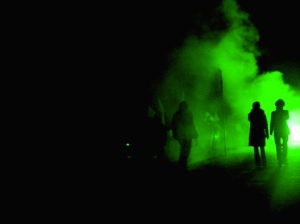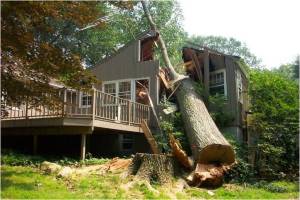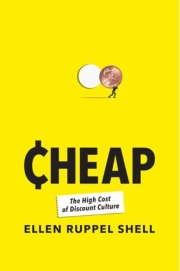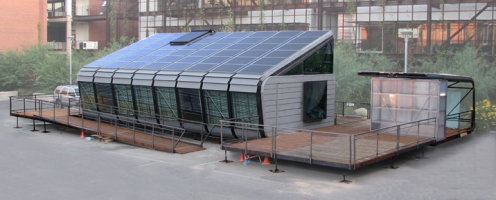After 4-1/2 years of tackling head-on the significant challenge of creating a successful pure-play green building products retail showroom in central Arizona, we closed a.k.a. Green’s doors in December of last year. Many people asked “why?” as we served as an anchor of the green building community in the Phoenix area and our reputation extended well beyond the Valley of the Sun. At the request of Green Building Product Dealer News and others, here are the primary reasons that went into that difficult decision. Some may not be what other dealers want to hear, but we hope that ideas herein can help strengthen those important and dedicated businesses:

1) The Economy. Operating a primarily retail products business in the development-addicted Phoenix market during the worst recession since the depression was about as easy as surfing on gravel. The December, 2009 news that Arizona’s economy was in worse immediate shape than Michigan’s did not come as a surprise to us. We saw a boost in business when the new home construction market collapsed as people who planned to flip their homes turned instead to remodeling as they realized they wouldn’t be selling for awhile. But then our sales fell off a cliff to the tune of 70% virtually overnight when the financial meltdown occurred. Home equity lines were yanked as home values plummeted, taking remodeling plans with them. Also, no job = no income = no home improvement. Our pool of contacts and friends here are skewed toward those in the development industry (the industry hardest hit), but easily half of them are either out of work or severely underemployed. It’s ironic that we have spoken out about the Valley’s unsustainable dependence on attracting new people here and then putting them to work building more resorts, buildings, and homes in order to attract more people here. The system actually did collapse as we predicted, but very suddenly, and much more severely than we anticipated. We couldn’t insulate ourselves.
2) Medium-term prospects: Living on the edge of writing checks into your business every month is precarious enough. In evaluating options, we didn’t expect the Phoenix building market to recover to reasonable levels for at least two years. It continues to be hard to predict. And at the end of the tunnel? Without any comprehensive standards for green products, in two years everyone will be carrying “green products”. In fact, our original goal of making green products available to the mainstream public will have been fulfilled… at least in the pronouncements of marketing departments. So, why live with no income and on the edge of significant debt for years only to have to split the potential rewards with every goliath chain retailer and others?
3) Suppliers: For years, we learned the hard way about manufacturers/suppliers who didn’t have their act together, didn’t stand behind their product, didn’t honor exclusivity promises, or who took us out at the knees by selling directly to our customers (often at prices equal to our cost). This is not to disparage the great suppliers with great product and supply chains. It was discouraging to work extremely hard to build awareness of a manufacturer’s products in a market devoid of their presence, and to not get the sale… or to have the manufacturer then make a deal with a distributor to siphon off the commercial projects, leaving us with retail crumbs and shrinking margins with another middleman. Yes, we were naïve, and it took us quite awhile to get our own operations running smoothly. But the hardest part was when the economy got rough for everyone and some of our most trusted manufacturers resorted to selling direct, even to consumers, in order to survive. They cut off their limbs to try to save their torso. So now we are gone but I assume they figure that new retailers will emerge when the market recovers, if they can only make it through until then.
4) Internet Retailers: During the last year, we really started to see the impact of out-of-state internet retailers cutting into our sales. Surprisingly, some of their retail pricing was below our cost. Tell me how that is possible, given none of them can be doing the kind of volume that would warrant those kind of manufacturer discounts. The kicker was when they seemed to actually be encouraging customers to continue to utilize our showroom and staff to pick styles and colors and even elicit our installer list. With their additional advantage of not having to charge sales tax, we could never match their pricing. I actually wonder about the longevity of the traditional retail business model, as these issues go way beyond our own industry. “Customer service is the key,” some might say. I have to chuckle because, although there is some validity to that, we actually had customers come in and want us to solve their warranty issues with a manufacturer for product that they bought online from an Internet retailer. The American consumer mentality of lowest first-cost and always looking for “the deal” is so pervasive that selling on quality of service is a more and more difficult challenge, particularly in a large, nomadic urban area. My partner, Jeff Frost, has talked extensively about the hidden costs of a discount economy in his series “The False Perception” on our blog.

Green Drinks @ a.k.a. Green
5) Business Model: Our revenue streams did not align with our activities or our real interests. We are change agentsand cause-driven advocates who were subsidizing our real interests through retail sales. We started and managed Green Drinks locally until it became so successful and time consuming that we decided to turn it over to the Green Chamber. We are national leaders in the USGBC and the American Green Chamber and we had a full-time marketing person whose assigned efforts for local not-for-profits took half her work schedule. We took on entrenched interests whose practices block market transformation. We hosted innumerable student tours and made countless presentations to community groups. None of that had revenue tied to it. And we were doing free marketing of products for others to get the sale. We even won a prestigious local award for community education, hitting something like 200 architecture and design firms in our first year. We are educators and we should have had our model reflect that. By the time we really figured that out, we did not have the resources to make the switch in the showroom and we knew that manufacturers would not have the marketing resources to back it up for some time.
6) Customer Base: It doesn’t work economically to spend hours educating a customer on something new and foreign to them, developing a customer relationship for a high-involvement purpose just for the one-off sale that may be thwarted by their contractor. How many times is the same retail customer going to buy flooring? You can justify some of that time investment in that a good customer experience will result in referral business. But the equation still doesn’t add up. Luckily, in the last year, more customers started coming in with some prior research and knowledge about green products. Still, we should have focused a much more concentrated effort earlier on developing the trades base. Trades Believers = Repeat sales. Unfortunately, in the beginning, the trades and builders weren’t interested because their customers weren’t asking for it and they were making money hand-over-fist with their traditional methods. So, we had to create the end-consumer demand first. But somewhere in there we should have shifted to a trades focus earlier. This is, of course, a local-market based timing decision.
7) The Information Age: We have come to expect that information is abundant and free. Most customers do not understand the costs of both knowledge creation and information exchange. It is expected that brick and mortar retailers provide expert advice, but a sense of reciprocity that the retailer deserves the sale to pay for that advice is very rare. It is the 45-minute interaction that is the killer. Too short to charge for but it chisels away significantly at payroll and through the other work that doesn’t get done. We adapted to this by providing fee-based educational seminars. This was successful until the financial meltdown, when consumers started viewing almost everything as discretionary spending. If we offered a seminar for free, it was packed. If we charged, we couldn’t get enough sign-ups anymore to make it worth pursuing. One key to educational seminars (besides quality and objectivity) is offering CEU’s or tying it to a certification.
8) Big Box Retailers and Discounters: Greater Phoenix is the land of Home Depots. Everywhere. Lowes has come into the market significantly, but everything is measured against Home Depot pricing. That is the reality against which we always had to make our case. Throw in some discount “wholesalers” selling products like engineered bamboo that fails in a hot, dry climate and suddenly we have to defend products (solid bamboo, in this case), as well.
The Future:
Our industry has been in rapid transformation for at least four years. That will continue, possibly even faster. I believe there are a few key strategy topics that need to go into any green building retailer pure-play planning, many of which are the same as described in our original business plan:
1) Consolidation: Either in the form of a roll-up or a co-op, retailers need to consolidate to gain critical mass in purchasing, the balance of power between suppliers and retailers, research, industry voice, and marketing.
2) Green Product Retailers Association: Yes, we got burned in Chicago in 2007 by one of the participants in our organizing session and everyone involved became gun-shy. However, this would have similar benefits to #1, above.
 3) Green Product Standards: a.k.a. Green has been pushing this since Day 1. The issue is complex and expensive, but the fastest first step would be for the FTC to update its Green Guides as to allowed and disallowed advertising methods… and enforce them rigorously. The rest needs to be sorted out by a consensus body (EPD’s vs. certification, thresholds vs. ratings, industry-specific vs. across-the-board, etc), but the independent retailers need to be at the table.
3) Green Product Standards: a.k.a. Green has been pushing this since Day 1. The issue is complex and expensive, but the fastest first step would be for the FTC to update its Green Guides as to allowed and disallowed advertising methods… and enforce them rigorously. The rest needs to be sorted out by a consensus body (EPD’s vs. certification, thresholds vs. ratings, industry-specific vs. across-the-board, etc), but the independent retailers need to be at the table.
4) Retail model: With information and product flowing freely across state lines and throughout the supply chain, aided by efficient shipping companies and a lack of inter-state sales tax, it might be time to re-think the brick and mortar model. We have ideas on a model that plays to these now-present market characteristics but will save them for another time.
5) Green Mainstreaming: If we are truly successful, “true green products” will be synonymous with “products”. So what will be the differentiation for a green products retailer? There are various market-positioning answers to that question.
6) Energy: The national focus from the feds down is going to be energy efficiency and renewables for some time. How can you leverage that without giving up your roots in indoor air quality, toxicity and natural resource depletion?
 For Jeff and myself, the closing of a.k.a. Green has led to much more work through a.k.a. Green Services, as clients and manufacturers now perceive we actually have time to devote to their consulting, design or certification projects. Our second online seminar, this one aimed at the general public, has launched through a new partnership with Rio Salado College. Hosting Greenbuild in Phoenix last year and closing the showroom also caused several projects to be pushed. We are just now starting to wrap those up, assess lessons learned from a.k.a. Green and contemplate our next long-term steps. And we look with admiration at those pure-play retailers who, either by choosing slightly better markets or by playing their cards smarter, continue to stick to their sustainability values in this difficult economic time. With the planet on a climate change ticking clock, rest assured you won’t be seeing “Mick and Jeff’s Hopped Up Hummer Shop” anytime soon but, rather, something that continues to help further the mission of healthier people and a sustainable planet.
For Jeff and myself, the closing of a.k.a. Green has led to much more work through a.k.a. Green Services, as clients and manufacturers now perceive we actually have time to devote to their consulting, design or certification projects. Our second online seminar, this one aimed at the general public, has launched through a new partnership with Rio Salado College. Hosting Greenbuild in Phoenix last year and closing the showroom also caused several projects to be pushed. We are just now starting to wrap those up, assess lessons learned from a.k.a. Green and contemplate our next long-term steps. And we look with admiration at those pure-play retailers who, either by choosing slightly better markets or by playing their cards smarter, continue to stick to their sustainability values in this difficult economic time. With the planet on a climate change ticking clock, rest assured you won’t be seeing “Mick and Jeff’s Hopped Up Hummer Shop” anytime soon but, rather, something that continues to help further the mission of healthier people and a sustainable planet.
Posted in Eco-Minded Events / Exhibitions, Educational, Energy, Environmental Impacts on Health, Green Architecture, Green Building, Green Building Products, Green Companies, Greenwashing, Indoor Environmental Quality, Sustainable Design, Sustainable Solutions, The Green Race, Toxicity









 3) Green Product Standards: a.k.a. Green has been pushing this since Day 1. The issue is complex and expensive, but the fastest first step would be for the FTC to update its Green Guides as to allowed and disallowed advertising methods… and enforce them rigorously. The rest needs to be sorted out by a consensus body (EPD’s vs. certification, thresholds vs. ratings, industry-specific vs. across-the-board, etc), but the independent retailers need to be at the table.
3) Green Product Standards: a.k.a. Green has been pushing this since Day 1. The issue is complex and expensive, but the fastest first step would be for the FTC to update its Green Guides as to allowed and disallowed advertising methods… and enforce them rigorously. The rest needs to be sorted out by a consensus body (EPD’s vs. certification, thresholds vs. ratings, industry-specific vs. across-the-board, etc), but the independent retailers need to be at the table. For Jeff and myself, the closing of a.k.a. Green has led to much more work through a.k.a. Green Services, as clients and manufacturers now perceive we actually have time to devote to their consulting, design or certification projects. Our second
For Jeff and myself, the closing of a.k.a. Green has led to much more work through a.k.a. Green Services, as clients and manufacturers now perceive we actually have time to devote to their consulting, design or certification projects. Our second  companies unscathed. We all have done it. We all have researched and found a product at a store, be it shoes, books or furniture, and rather than buy the product, we go home and “Google-it” to see if we can find a cheaper price. Now of course the pricing fluctuations can be enormous but, in most cases it is marginal. Usually less than 10%. I can give an example. I am in the market for new hiking shoes. I really like Merrell shoes for performance on the trail but they are expensive… often $110 a pair. So, to ‘check’ pricing online, I did some research to see if I could find a cheaper price. What I found was that Amazon sells them for $101 with free ‘SuperSaver” shipping. Theoretically saving me $9. But as we learned in our last two parts… at what cost?
companies unscathed. We all have done it. We all have researched and found a product at a store, be it shoes, books or furniture, and rather than buy the product, we go home and “Google-it” to see if we can find a cheaper price. Now of course the pricing fluctuations can be enormous but, in most cases it is marginal. Usually less than 10%. I can give an example. I am in the market for new hiking shoes. I really like Merrell shoes for performance on the trail but they are expensive… often $110 a pair. So, to ‘check’ pricing online, I did some research to see if I could find a cheaper price. What I found was that Amazon sells them for $101 with free ‘SuperSaver” shipping. Theoretically saving me $9. But as we learned in our last two parts… at what cost?



 You can look at investments in much the same way. Previous generations looked at investing over the long term, often looking at returns for when they retired. Furniture was also passed on from generation to generation because it was built to last forever. Looking back several generations, the mantra has always been
You can look at investments in much the same way. Previous generations looked at investing over the long term, often looking at returns for when they retired. Furniture was also passed on from generation to generation because it was built to last forever. Looking back several generations, the mantra has always been 


 I only watch Glenn Beck (or Keith Oberman, for that matter) when I am in an airport somewhere waiting for a flight and I try to make sure there is no food in my stomach at the time, so I don’t know much about his campaign to oust Jones or about the campaign conducted by opposing groups to have advertisers boycott Beck’s show for calling President Obama a racist. I DID see a bit of Beck’s teary “what has so divided us?” plea as he ripped into all politicians as evil and I wondered what planet I was on. As many of our mothers used to say “If you don’t have anything good to say….” Anyway, I digress….
I only watch Glenn Beck (or Keith Oberman, for that matter) when I am in an airport somewhere waiting for a flight and I try to make sure there is no food in my stomach at the time, so I don’t know much about his campaign to oust Jones or about the campaign conducted by opposing groups to have advertisers boycott Beck’s show for calling President Obama a racist. I DID see a bit of Beck’s teary “what has so divided us?” plea as he ripped into all politicians as evil and I wondered what planet I was on. As many of our mothers used to say “If you don’t have anything good to say….” Anyway, I digress….